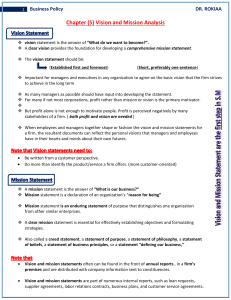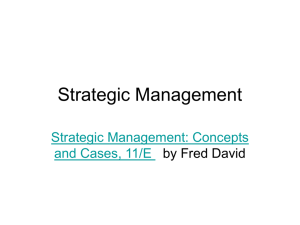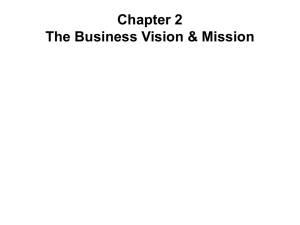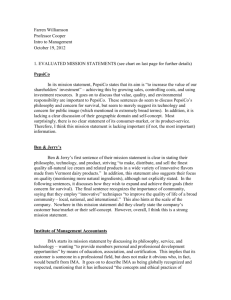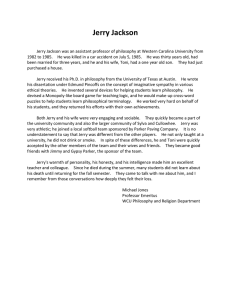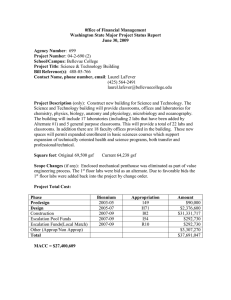lec 6
advertisement
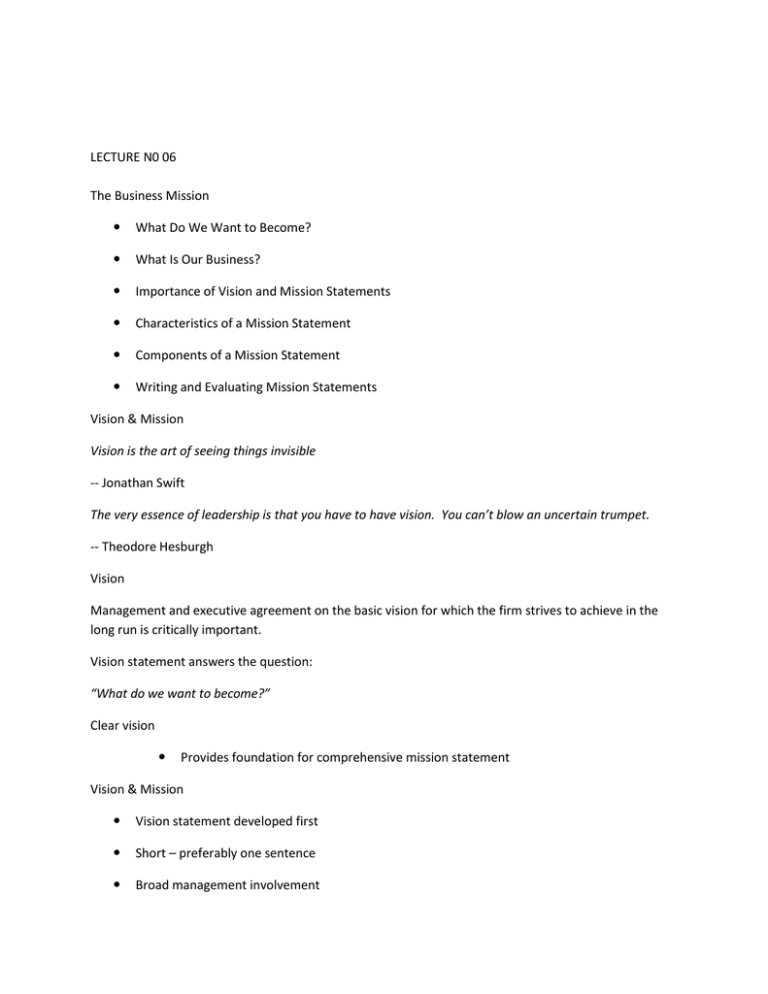
LECTURE N0 06 The Business Mission What Do We Want to Become? What Is Our Business? Importance of Vision and Mission Statements Characteristics of a Mission Statement Components of a Mission Statement Writing and Evaluating Mission Statements Vision & Mission Vision is the art of seeing things invisible -- Jonathan Swift The very essence of leadership is that you have to have vision. You can’t blow an uncertain trumpet. -- Theodore Hesburgh Vision Management and executive agreement on the basic vision for which the firm strives to achieve in the long run is critically important. Vision statement answers the question: “What do we want to become?” Clear vision Provides foundation for comprehensive mission statement Vision & Mission Vision statement developed first Short – preferably one sentence Broad management involvement Vision Statements The Vision of the National Pawnbrokers Association is to have complete and vibrant membership that enjoys a positive public and political image and is the focal organization of all pawn associations. --National Pawnbrokers Association Vision Statements The Bellevue Hospital is the LEADER in providing resources necessary to realize the community’s highest level of HEALTH throughout life. --The Bellevue Hospital To be the first choice in the printed communications business. The first choice is the best choice, and being the best is what Atlanta Web pledges to work hard at being - every day! --Atlanta Web Printers, Inc. It is the vision of the California Energy Commission for Californians to have energy choices that are affordable, reliable, diverse, safe, and environmentally acceptable. --California Energy Commission Mission Statements Recent Data indicate that: 90% of all companies have used a mission statement sometime in the previous five years. Mission statement answers the question: “What is our business?” Mission Statements Mission Statement: Enduring statement of purpose Distinguishes one organization from another in similar enterprises Declaration of an organization’s “reason for being” Mission Statements also referred to as: Creed statement Statement of purpose Statement of philosophy Statement of business principles Mission Statements Reveal what an organization wants to be and whom it wants to serve Mission Statements Essential for effectively establishing objectives and formulating strategies Many organizations develop both vision and mission statements Profit and vision are necessary to effectively motivate a workforce Shared vision creates a commonality of interests Developing Vision & Mission Clear mission is needed before alternative strategies can be formulated and implemented Important to have as broad range of participation as possible among managers in developing the mission Mission Statement “The Bellevue Hospital, with respect, compassion, integrity, and courage, honors the individuality and confidentiality of our patients, employees, and community, and is progressive in anticipating and providing future health care services.” Mission Characteristics Effective mission statements: • Broad in scope • Generate range of feasible strategic alternatives • Not excessively specific • Reconcile interests among diverse stakeholders • Finely balanced between specificity & generality Effective mission statements: • Arouse positive feelings and emotions • Motivate readers to action • Generate the impression that firm is successful, has direction, and is worthy of time, support, and investment Customer Orientation According to Vern McGinnis, mission should: Define what the organization is Define what the organization aspires to be Limited to exclude some ventures Broad enough to allow for creative growth Distinguish the firm from all others Serve as framework to evaluate current activities Stated clearly so that it is understood by all A good mission statement reflects the anticipations of customers. Identify customer needs Provide product/service to satisfy needs AT&T’s mission focuses on communications, not telephones Exxon’s mission focuses on energy, not on oil and gas Social Policy & Mission Managerial philosophy and thinking at the highest levels in the organization reflect social policy. Affects development of vision & mission Responsibilities to consumers, environmentalists, minorities, communities, & other groups Social policy should be integrated in all strategic-management activities. Mission statement is an effective instrument for conveying the social responsibility of the firm. Customers Products or services Markets Technology Survival, growth, and profitability Philosophy Self-concept Concern for public image Concern for employees Components of Mission Components of mission and corresponding questions to be answered: Customers: “Who are the firm’s customers?” Products or services: “What are the firm's major products or services?” Markets: “Geographically, where does the firm compete?” Technology: “Is the firm technologically current?” Concern for survival, growth, and profitability: “Is the firm committed to growth and financial soundness?” Philosophy: “What are the basic beliefs, values, aspirations, and ethical priorities of the firm?” Self-concept: “What is the firm’s distinctive competence or major competitive advantage?” Concern for public image: “Is the firm responsive to social, community, and environmental concerns?” Concern for employees: “Are employees a valuable asset of the firm?” Importance of Vision & Mission Although research results are mixed, firms with formal mission statements… • 2X average return on shareholder’s equity • Positive relationship to organizational performance • 30% higher return on certain financial measures PepsiCo Mission Statement PepsiCo’s mission is to increase the value of our shareholders’ investment. We do this through sales growth, cost controls, and wise investment resources. We believe our commercial success depends upon offering quality and value to our consumers and customers; providing products that are safe, wholesome, economically efficient and environmentally sound; and providing a fair return to our investors while adhering to the highest standards of integrity. Ben & Jerry’s Mission Statement Ben & Jerry’s mission is to make, distribute and sell the finest quality all-natural ice cream and related products in a wide variety of innovative flavors made from Vermont dairy products. To operate the Company on a sound financial basis of profitable growth, increasing value for our shareholders, and creating career opportunities and financial rewards for our employees. To operate the Company in a way that actively recognizes the central role that business plays in the structure of society by initiating innovative ways to improve the quality of life of a broad community—local, national and international. Summary and explanation : Organizations sometimes summarize goals and objectives into a mission statement and/or a vision statement. Others begin with a vision and mission and use them to formulate goals and objectives. Many people mistake the vision statement for the mission statement, and sometimes one is simply used as a longer term version of the other. However they are distinct; with the vision being a descriptive picture of a desired future state and the mission being a statement of a rationale, applicable now as well as in the future. The mission is therefore the means of successfully achieving the vision For an organization's vision and mission to be effective, they must become assimilated into the organization's culture. They should also be assessed internally and externally. The internal assessment should focus on how members inside the organization interpret their mission statement. The external assessment which includes all of the businesses stakeholders is valuable since it offers a different perspective. These discrepancies between these two assessments can provide insight into their effectiveness.

